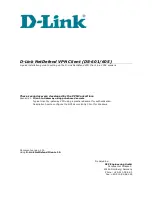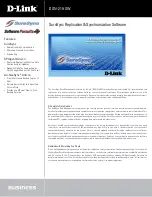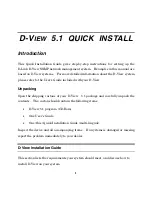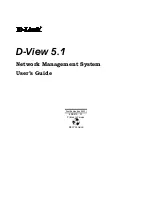
The Grouping Manager
EPICenter Reference Guide
222
You can define your own groups at the same hierarchical level as the predefined groups, or as
subordinate groups (children) of an existing group. You can assign resources to your own user-defined
groups and to the predefined groups, with the exception of Device Groups and Import Sources.
The Device group always has the child group named “Default”. It may or may not have additional
members depending on whether devices have been added to the device groups in the Inventory
Manager. You cannot directly add members to Device Groups using the Grouping Manager. This must
be done in the Inventory Manager.
Four of the predefined groups—Custom Applications, Hosts, Port Groups, and Users—initially have no
members. Although the latter three groups are provided to help you organize your host, user, and port
resources, they can contain children of any resource type. A Custom Applications group can only
contain port resources. You can create new groups as members of these groups, or add resources of any
type directly to them. The Custom Applications group cannot have hierarchical children.
●
Custom Applications may be used to group various L4 resources without requiring ports in the
group to be contiguous or of uniform type. For instance, you can mix UDP and TCP ports in one
group. You can also have sets of contiguous ports and single ports in the same group.
●
Port Groups may be used by the Real Time Statistics applet and the IP/MAC Address Finder applet.
However, these applets do not support hierarchical groups—if you have subordinate groups within
a port group, the subordinate layers are all collapsed into a single layer. Resources of types other
than ports are ignored by these applets.
Port Groups, along with all the other types of groups and resources, may also be used by the
optional Policy Manager.
●
The Hosts and Users groups (either the predefined groups or subordinate groups) may be used by
the optional Policy Manager. This is also true of all user-defined groups. No other EPICenter applets
currently support groups of these types.
In a group that contains resources of different types, the Policy Manager ignores those resources that
are not relevant to the purpose for which the group has been selected.
The other two predefined groups, the Device Groups and the Import Sources, are restricted in the way
they can be used.
Device Groups.
The Device Groups group contains the device groups and devices known to the
EPICenter inventory database. Device groups are created within the Inventory Manager applet, and
devices are added or discovered, and are assigned to device groups, within that applet. All port
resources are also defined in association with the devices known to the Inventory Manager.
●
You cannot add resources to or remove resources from the Device Groups group through the
Grouping Manager.
●
You can add resources that are children of Device Groups group—device groups, devices, and
ports—as members (children) of other groups.
●
There is always a device group named “Default”.
Import Sources.
The Import Sources group is used to contain resources imported from an external
source, such as a file, NT Domain Controller, or LDAP directory. When you perform an import
operation, the Grouping Manager creates a new group under the Import Sources group and puts all the
imported resources under that group.
●
You cannot add groups or individual resources as children of the Import Sources group except by
using the Import function.
Содержание EPICenter 6.0
Страница 14: ...EPICenter Reference Guide 14 ...
Страница 18: ...Preface EPICenter Reference Guide 18 ...
Страница 19: ...1 EPICenter Basic Features ...
Страница 20: ......
Страница 24: ...EPICenter Overview EPICenter Reference Guide 24 ...
Страница 44: ...Getting Started with EPICenter EPICenter Reference Guide 44 ...
Страница 100: ...The Inventory Manager EPICenter Reference Guide 100 ...
Страница 140: ...The EPICenter Alarm System EPICenter Reference Guide 140 ...
Страница 172: ...Configuration Manager EPICenter Reference Guide 172 ...
Страница 196: ...The Firmware Manager EPICenter Reference Guide 196 ...
Страница 220: ...The Interactive Telnet Feature EPICenter Reference Guide 220 ...
Страница 250: ...The Grouping Manager EPICenter Reference Guide 250 ...
Страница 276: ...Real Time Statistics EPICenter Reference Guide 276 ...
Страница 295: ...The New Menu EPICenter Reference Guide 295 Figure 137 Example of a default layout for a 500 node map ...
Страница 342: ...Using the VLAN Manager EPICenter Reference Guide 342 ...
Страница 348: ...The ESRP Monitor EPICenter Reference Guide 348 ...
Страница 446: ...EPICenter Reports EPICenter Reference Guide 446 ...
Страница 447: ...2 Advanced Upgrade Features ...
Страница 448: ......
Страница 480: ...EAPS Protocol Monitoring and Verification EPICenter Reference Guide 480 ...
Страница 508: ...Using the Policy Manager EPICenter Reference Guide 508 ...
Страница 525: ...3 Appendices ...
Страница 526: ......
Страница 542: ...EPICenter Backup EPICenter Reference Guide 542 ...
Страница 564: ...Voice over IP Manager EPICenter Reference Guide 564 ...
Страница 580: ...EPICenter Reference Guide 580 ...
















































